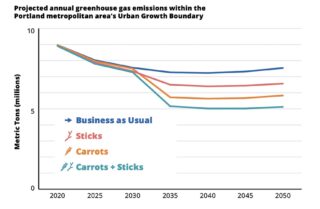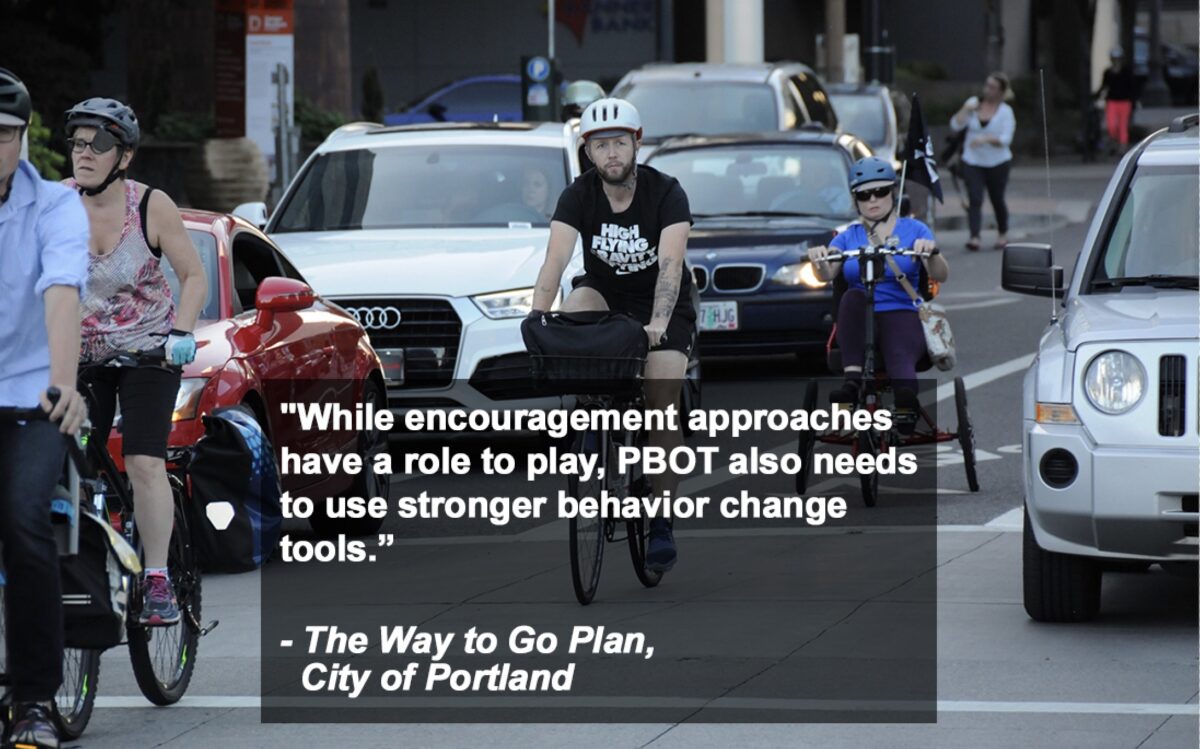
This week at city council, Transportation Commissioner Jo Ann Hardesty will ask her colleagues to adopt a new plan for how Portland promotes the type of trips that will create a more healthy and humane city — while discouraging ones that do the opposite. Given that the same council meeting will include adoption of the Pricing Options for Equitable Mobility (POEM) report, Portland city government is finally poised for a more aggressive approach to influencing transportation choices.
The City of Portland has a long legacy of encouraging people to drive less (what’s known as transportation demand management, or TDM). The Bureau of Transportation (PBOT) worked with employers to boost transit use as far back as the 1990s and created a Transportation Options Division within the agency in 2000. But while their work in this field has been laudable, it’s been almost 100% carrots and very few sticks. This has led to a worrying increase in driving in the past decade. According to U.S. Census data (in chart below), there were 95,211 more commuters in 2019 relative to 2000. Between 2010 and 2019, Portland added 46,174 solo car drivers — by far the largest increase of any mode. By comparison, Portland added just 2,707 bike commuters over the same timeframe.
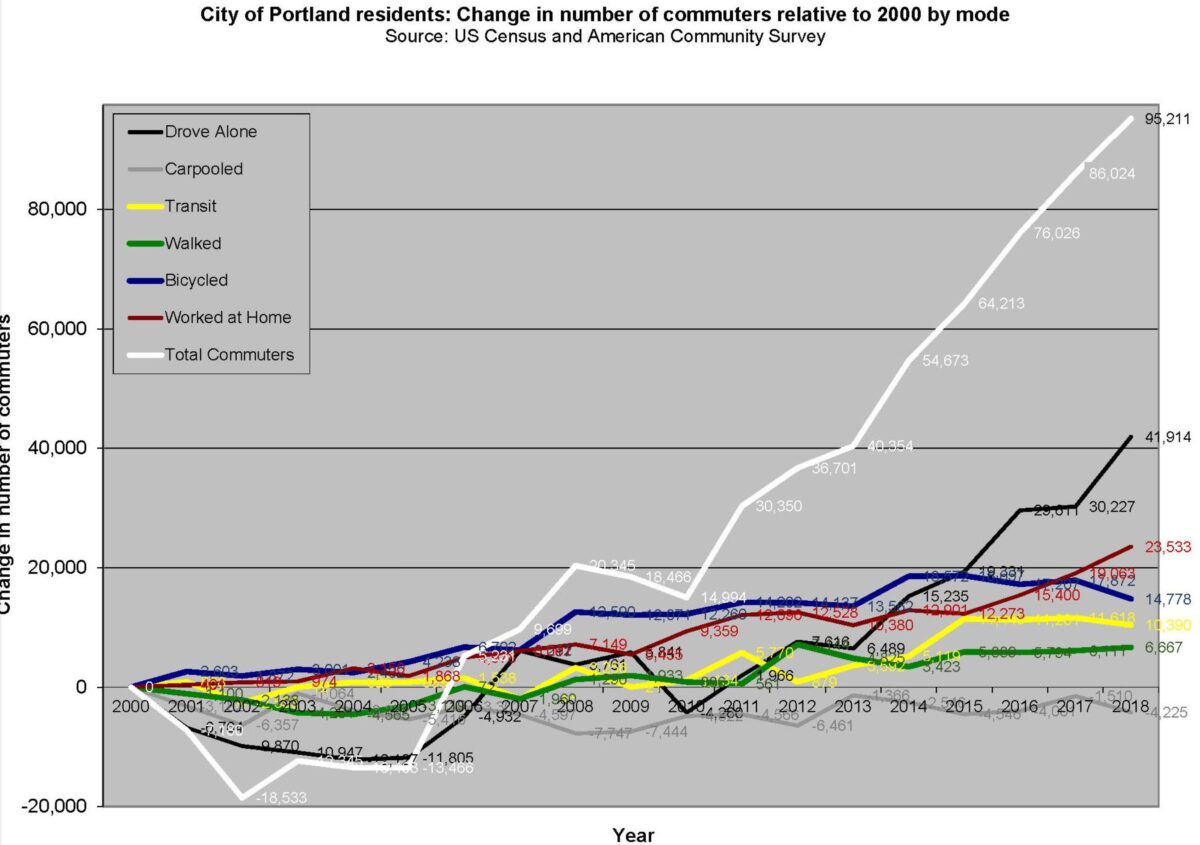
Finally, with the political and public mood around the climate crisis and systemic inequities at all-time highs, a new plan provides a foundation for PBOT to shift their approach and change Portland’s troubling transportation trajectory.
The latest feather in PBOT’s TDM cap is the new Way to Go Plan (PDF) that will be at council Wednesday. The plan is notable because it organizes all PBOT’s best practices and ideas into one cohesive vision for the first time. Beyond just laying out a vision, the plan shares a detailed look at how PBOT plans to shift trips away from the outdated one-person-one-car paradigm and toward choices like bicycling, scooting, walking, and so on. The plan also includes a list of specific actions the bureau is working on and aims to complete within the next two years.
Keep in mind that since the publication of their 2019-2022 Strategic Plan, PBOT asks two overarching questions as they approach every policy discussion: “Will it advance equity and address structural racism?” and “Will it reduce carbon emissions?”.
Advertisement
I think that first question has been challenging for PBOT to balance with any policy or program that seeks to change transportation behavior. For instance, they’ve known for years that pricing car trips is an effective strategy to reduce driving, but they’ve worried about a general unease from the public that it was in conflict with equity goals (it’s not). Now PBOT is saying out loud what some activists have been screaming for years:
“While encouragement approaches have a role to play — particularly when used at the right time to enhance major capital projects and programmatic activities — PBOT also needs to use stronger behavior change tools,” reads the report. They even make the point in a chart:
PBOT says the reason many Portlanders of color aren’t bicycling or using transit or scooters isn’t because they don’t like to. Rather, it’s often because there are structural barriers in their way like cost, general public safety concerns, and living too far away from destination and resource-rich neighborhoods.
To address these disparities and encourage people to stop driving so much, PBOT studied nine “strategic priority areas” and evaluated each one’s potential impact on vehicle miles traveled (VMT) reduction and overcoming equity disparities.
The nine priority areas listed in the plan (in order of estimated impact) are:
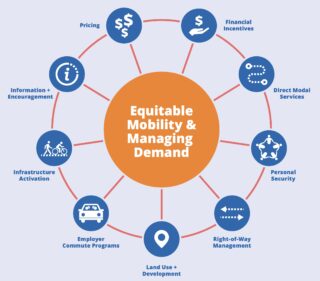
Pricing – Fees, charges, and tolls—designed intentionally and equitably to manage demand.
Financial Incentives – … discounted passes, subsidies, and reimbursements — make using travel options more cost-competitive…
Direct Modal Services – Increasing the number, frequency, and reliability of transportation options, like transit, bike-share, scooter-share, car-share, and more…
Personal Security – People need to be and feel safe when taking transit, biking, walking, and rolling, so they don’t feel the need to travel in their own enclosed vehicle for every trip.
Right-Of-Way Management – Projects are built and road space is allocated to prioritize non-driving modes…
Land Use + Development – Neighborhoods and developments are planned… in ways that make it easier to walk, bike, roll, and take transit.
Employer Commute Programs – Working through and with employers to influence the ways their employees get to work…
Infrastructure Activation – New infrastructure… delivered in tandem with culturally appropriate community outreach, education, and other support.
Information + Encouragement – People need to know about their transportation options…
According to research conducted for PBOT by consultants from Fehr & Peers, making driving more expensive holds the most potential. “Converting workplace parking from free to paid is likely to result in a commute VMT reduction of 15 to 30 percent for employees commuting to workplaces where it is implemented, with a greater reduction in areas near high-quality transit and bicycle facilities,” reads a memo from the consultants.
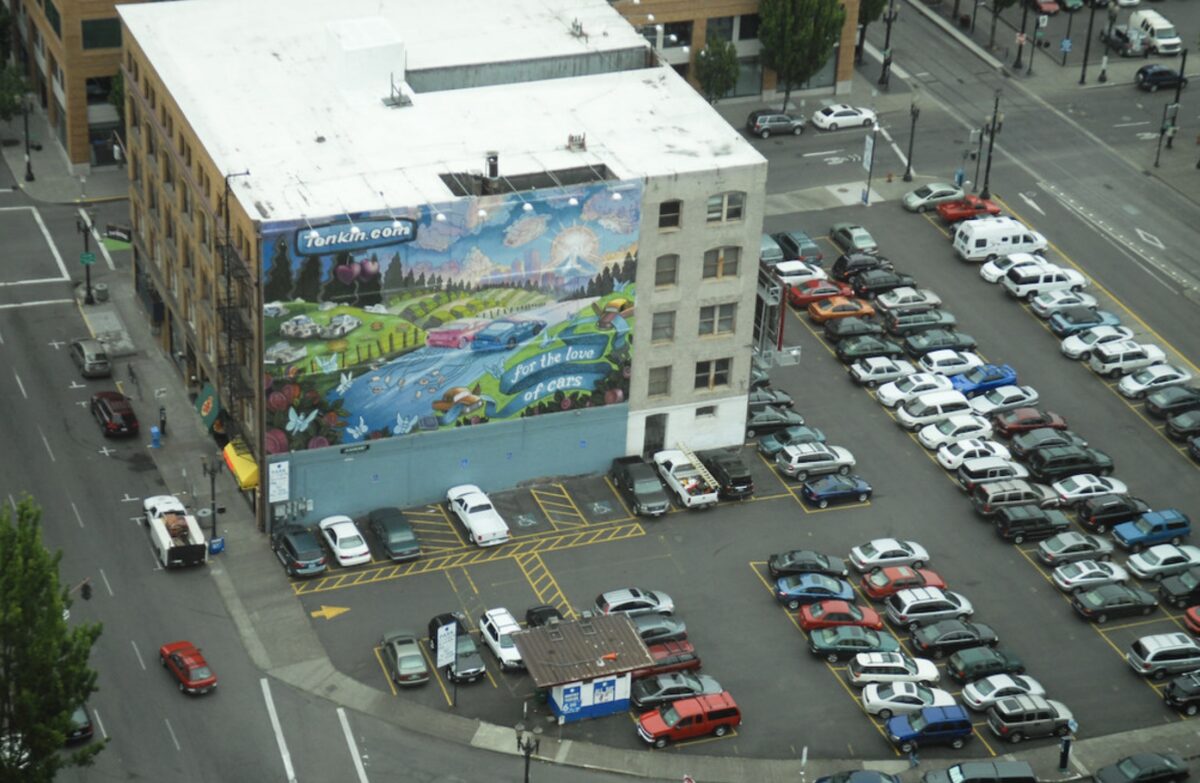
On the pricing front, PBOT says in the next two years they plan to (among other things): create a parking cash-out program for employers, create new parking meter districts, unbundle parking lots (charge a fee for parking even on privately-owned lots, something that has had excellent results in Seattle), create new fees for delivery companies, advocate for an amendment to the Oregon constitution to end spending constraints on revenue generated through taxes on motor vehicle owners, explore a central city “cordon” where car users would have to pay a toll to enter, and consider free or reduced parking for residents of “historically underserved neighborhoods” that would be paid for with a surcharge in other areas.
PBOT also says they plan to make the electric scooter share system permanent and increase the Biketown fleet to 2,500 bikes in the next two years.
When it comes to right-of-way management, the plan hints as a new “Healthy Back to School’s School Streets Program,” and making even more of the pandemic-inspired “Slow Streets” installations permanent.
This is a very promising new plan and we’ll be watching PBOT closely to see how/if/when they implement its recommendations. For more info, check out the council resolution which has links to the plan and appendix.
— Jonathan Maus: (503) 706-8804, @jonathan_maus on Twitter and jonathan@bikeportland.org
— Get our headlines delivered to your inbox.
— Support this independent community media outlet with a one-time contribution or monthly subscription.


